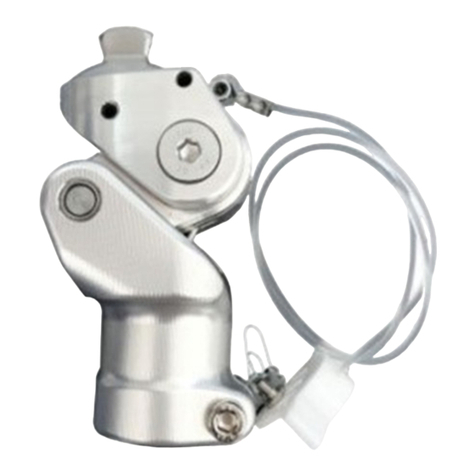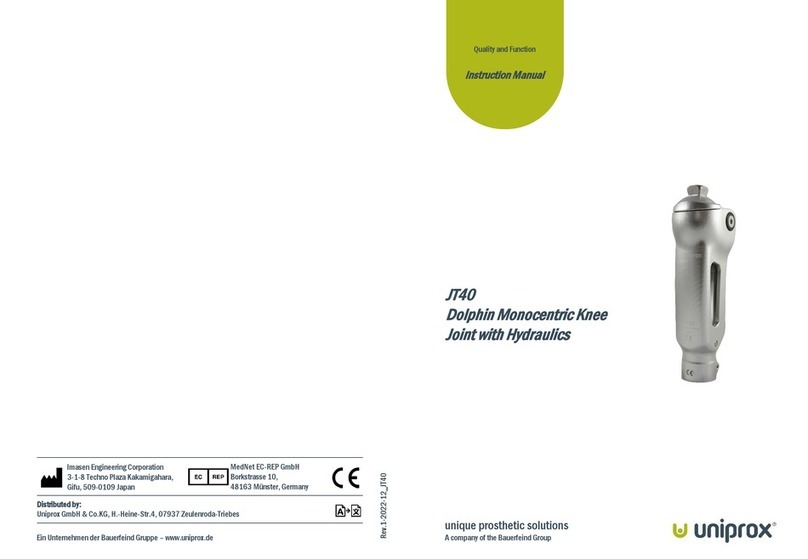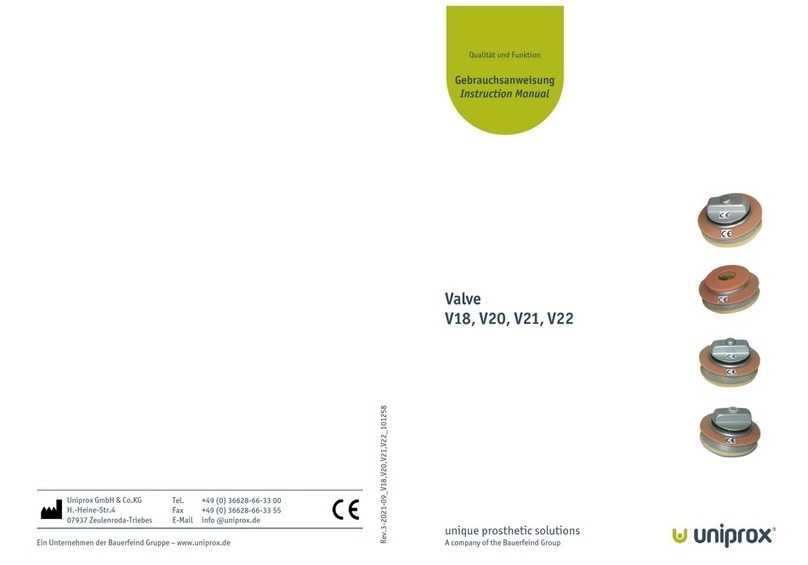
4 5
3. Indication/ Contraindication
Indication:
•Transfemoral amputation
•Knee disarticulations
Contraindication:
•Residual muscular wea ness, contractures or proprioceptive dysfunction including
poor balance
•Inability to comprehend instructions
•Contra lateral joint instabilities or pathology
•Complicated conditions involving multiple disabilities
4. Side effects
There are no nown side effects.
5. General safety instructions
•This medical device is designed for single patient, multiple use.
•Fitting/service of this medical device is only allowed by a certificated orthopedic
professional.
•The professional should instruct the correct use of the device to the user.
•The joint must be protected against dust, moisture, aggressive media, and
mechanical forces so its function is not affected.
•The joint is intended for use at temperatures from -10°C to 50°C.
•Do not longer use the nee joint if its function is impaired. This may be due to
stiffness, restricted extension, noise generation, faulty swing phase control or
stance phase safety, as well as impact from an external force (for example, if
dropped). In such cases, it must be chec ed by a professional and, if necessary,
sent to Uniprox GmbH & Co. KG.
•There is a ris of jamming when the joint is in use.
•The product must not be changed or applied in any improper way. Non-compliance
can impair the function of the product and thus no liability will be accepted.
•The safety of the user is not guaranteed if the product is not used for its intended
purpose. This will also terminate the warranty of the product.
•Joint components may heat up slightly during wal ing.
•Silicone spray should be used to prevent noises being generated by contact
between the cosmetic foam and nee joint. Do not use Talcum powder as it removes
lubricant from the bearings and may lead to impaired function as a result.
6. Assembly
Polycentric nee joints with geometric loc ing, integrated pneumatic end stop
damping, and an adjustable mechanical spring extension assist to provide an
extension moment.
Additional for JT22/ JT22S:
•The pneumatic swing phase damping has an integrated nozzle valve for self-
adjustment per the individual user‘s wal ing speed.
•At low wal ing speeds, the nozzle valve offers slight damping resistance against
flexion of the lower leg. As the speed increases, there is an increase in
accumulated pressure before the nozzle, which increases the damping resistance
against flexion of the lower leg. The damping effect restricts flexion of the lower
leg. A high-performance extension unit accelerates the lower leg through the
extension phase until the adjustable end stop damping gently absorbs the
movement.
Additional for JT20S/ JT22S:
•The adjustable, heel-activated flexible Stance-Control (Bouncing) ensures
additional stability. At heel stri e at the start of the stance phase, the flexible
element of the posterior rod contracts, whilst the adjustable primary flexion
enabling a flexion angle of between 0° and 5° (bouncing). The intersection of the
connecting lines of the front and rear axles can be set closer together. With more
of the load being transferred to the prosthesis, the resulting instantaneous center
of rotation of the 4-axle joint lin chain experiences increasing dorsal-proximal
displacement and is thereby more secure against unintentional flexion.



























